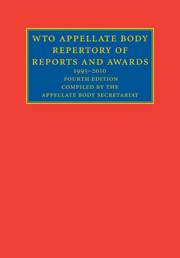Book contents
- Frontmatter
- Contents (outline)
- Contents (detail)
- Foreword to the 1995–2010 edition
- Part I Appellate Body Reports
- A
- B
- C
- D
- E
- F
- G
- H
- I
- J
- L
- M
- N
- O
- P
- R
- S
- T
- V
- W
- Part II Arbitration Awards under Article 21.3(c) of the DSU
- Annex A Terms of Office of Current and Former Appellate Body Members and Chairpersons – 31 December 2009
- Annex B Biographies of Current and Former Appellate Body Members
- Annex C Information on Appellate Body Reports – 1996 to January 2010
- Annex D Arbitration Awards under Article 21.3(c) of the DSU – 1996 to 2009
- Annex E Articles of Covered Agreements Addressed in Appellate Body Reports
- Annex F Working Procedures for Appellate Review WT/AB/WP/61
- Abbreviations used in the Table of References to the Covered Agreements and other Instruments and in the Indexes
- Table of References to the Covered Agreements and other Instruments by Article
- Index
- Subject Index by Case (Appellate Body reports)
- Subject Index by Case (Arbitration Awards under Article 21.3(c) of the DSU)
D
from Part I - Appellate Body Reports
Published online by Cambridge University Press: 05 June 2012
- Frontmatter
- Contents (outline)
- Contents (detail)
- Foreword to the 1995–2010 edition
- Part I Appellate Body Reports
- A
- B
- C
- D
- E
- F
- G
- H
- I
- J
- L
- M
- N
- O
- P
- R
- S
- T
- V
- W
- Part II Arbitration Awards under Article 21.3(c) of the DSU
- Annex A Terms of Office of Current and Former Appellate Body Members and Chairpersons – 31 December 2009
- Annex B Biographies of Current and Former Appellate Body Members
- Annex C Information on Appellate Body Reports – 1996 to January 2010
- Annex D Arbitration Awards under Article 21.3(c) of the DSU – 1996 to 2009
- Annex E Articles of Covered Agreements Addressed in Appellate Body Reports
- Annex F Working Procedures for Appellate Review WT/AB/WP/61
- Abbreviations used in the Table of References to the Covered Agreements and other Instruments and in the Indexes
- Table of References to the Covered Agreements and other Instruments by Article
- Index
- Subject Index by Case (Appellate Body reports)
- Subject Index by Case (Arbitration Awards under Article 21.3(c) of the DSU)
Summary
Development
See Enabling Clause (E.1); SCM Agreement, Article 27 – Special and differential treatment for developing country Members (S.2.35)
Directly competitive or substitutable products
See also National Treatment, Article III:2 of the GATT 1994, second sentence – “directly competitive or substitutable” products (N.1.6); Textiles and Clothing Agreement, Article 6.2 – “directly competitive products” (T.7.4)
(WT/DS75/AB/R, WT/DS84/AB/R)
The term “directly competitive or substitutable” describes a particular type of relationship between two products, one imported and the other domestic. It is evident from the wording of the term that the essence of that relationship is that the products are in competition. This much is clear both from the word “competitive” which means “characterized by competition”, and from the word “substitutable” which means “able to be substituted”. The context of the competitive relationship is necessarily the marketplace since this is the forum where consumers choose between different products. Competition in the market place is a dynamic, evolving process. Accordingly, the wording of the term “directly competitive or substitutable” implies that the competitive relationship between products is not to be analysed exclusively by reference to current consumer preferences. In our view, the word “substitutable” indicates that the requisite relationship may exist between products that are not, at a given moment, considered by consumers to be substitutes but which are, nonetheless, capable of being substituted for one another.
- Type
- Chapter
- Information
- WTO Appellate Body Repertory of Reports and Awards1995–2010, pp. 315 - 328Publisher: Cambridge University PressPrint publication year: 2011



